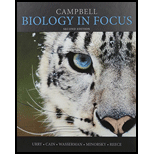
To determine:
What are the short-term changes in animal’s cardiovascular function that might facilitates use of skeletal muscle to escape dangerous situation.
Introduction:
Cardiovascular system is also as known as circulatory system. It is used to transport nutrients, oxygen, amino acids electrolytes, and hormones through blood and take out carbon dioxide and toxins from the body. It also helps in fighting diseases. It consists of blood and lymph. Blood is a fluid consists of red blood cell, white blood cell and plasma. Heart is a muscular tissue and is the main component of circulatory system.
Skeletal muscle is a voluntary muscle which is attached to bone and form nerve tissues, tendons, blood vessels, muscle tissue. It has ability to contract and relax and facilitate movement of body parts.
Want to see the full answer?
Check out a sample textbook solution
Chapter 34 Solutions
Campbell Biology in Focus; Modified Mastering Biology with Pearson eText -- ValuePack Access Card -- for Campbell Biology in Focus (2nd Edition)
- how can swimming improves the cardiovascular fitness of a person?arrow_forwardA large grasshopper and a small mouse may be similar in size. However, the total length of blood vessels is much greater in the mouse, and the mouse’s heart pumps at much higher pressure than the grasshopper’s hearts. Which statement is most useful for explaining these observations?arrow_forwardWhat are the important differences in the overall metabolic needs of a fish and a turtle and the ability of their circulatory systems to meet those needs? Select all that apply. Fish are less able to meet their metabolic needs than are turtles. Fish have a two-chamber heart (one atrium and one ventricle) and turtles have a three-chambered heart (two atria and one ventricle). Turtles are endothermic and fish are ectothermic Blood flows directly to other organs after being oxygenated in turtles, but return to the heart after being oxygenated in fish. Turtles have a double,-circuit circulatory system whereas fish have a single circulatory system.arrow_forward
- Three circulatory systems of vertebrates are represented in the following diagram. Identify to which group of animals each circulatory system belongs and mention the reasons for considering them as such. ↑ Capilares de las branquias Aorta Capilares sanguíneos ↓ Capilares pulmonares Aorta Capilares sanguíneos ↓ Capilares pulmonares Aorta Capilares sanguineosarrow_forwardThe mammalian heart can beat without input from the brain. True Or false?arrow_forwardDescribe the effect of an increased calcium ion (Ca++) concentration on the frog’s heart rate.arrow_forward
- As a result of heart failure, compensatory mechanisms become activated and ultimately lead to further harmful consequences in the long term. Which of the following is NOT one such compensatory mechanism? O Baroreceptor-mediated activation of the sympathetic nervous system that leads to increased heart rate and contractility The activation of renin-angiotensin-aldosterone system (RAAS) that leads to increased blood pressure increased cardiac preload A reduction in both heart rate and blood pressure O Myocardial hypertrophy resulting in the thickening of the ventricular wallarrow_forwardConstruct a model for the relationship between the heart rate of mammals and theirweight. Also give all assumptions you make.You may assume the following:arrow_forwardWhen the alary muscles contract, the hemolymph is forced through the aorta into the head. Upon relaxation, the hemolymph enters the heart through the ostia. Once the hemolymph leaves the aorta, it fills the perineural and perivisceral sinuses, bathing the internal organs at the same time. Present your understanding of this concept through a diagram in the activity worksheet.arrow_forward
- Descrive (in the correct order) the sequence of the blood flow through a four chambered mammalian heart. Be sure to address the following: 1. Begin with the return of oxygen poor blood from the body. 2. Describe the chemical O2/ CO2 and glucose content of the blood in the key locations. 3. Describe the machanisms that regulate the functioning of the system to maintain homeostasis.arrow_forwardWhy does heart rate and contraction force change relative to resting values when the frog's heart was cooled?arrow_forwardAn artificial heart works in closed loop by varying its pumping rate according to changes in signals from the recipient's nervous system. For feedback compensation design it is important to know the heart's open-loop transfer function. To identify this transfer function, an artificial heart is implanted in a calf while the main parts of the original heart are left in place. Then the atrial pumping rate in the original heart is measured while step input changes are effected on the artificial heart. It has been found that. in general, the obtained response closely resembles that of a second-order system. In one such experiment it was found that the step response has a %OS = 30% and a time of first peak 7, 127 sec (Nakamura, 2002). Find the corresponding transfer function. Aside from the corresponding transfer function, determine the following as well: delay time, rise time, settling time and steady state error if input is a step response. CO Marrow_forward
 Human Anatomy & Physiology (11th Edition)BiologyISBN:9780134580999Author:Elaine N. Marieb, Katja N. HoehnPublisher:PEARSON
Human Anatomy & Physiology (11th Edition)BiologyISBN:9780134580999Author:Elaine N. Marieb, Katja N. HoehnPublisher:PEARSON Biology 2eBiologyISBN:9781947172517Author:Matthew Douglas, Jung Choi, Mary Ann ClarkPublisher:OpenStax
Biology 2eBiologyISBN:9781947172517Author:Matthew Douglas, Jung Choi, Mary Ann ClarkPublisher:OpenStax Anatomy & PhysiologyBiologyISBN:9781259398629Author:McKinley, Michael P., O'loughlin, Valerie Dean, Bidle, Theresa StouterPublisher:Mcgraw Hill Education,
Anatomy & PhysiologyBiologyISBN:9781259398629Author:McKinley, Michael P., O'loughlin, Valerie Dean, Bidle, Theresa StouterPublisher:Mcgraw Hill Education, Molecular Biology of the Cell (Sixth Edition)BiologyISBN:9780815344322Author:Bruce Alberts, Alexander D. Johnson, Julian Lewis, David Morgan, Martin Raff, Keith Roberts, Peter WalterPublisher:W. W. Norton & Company
Molecular Biology of the Cell (Sixth Edition)BiologyISBN:9780815344322Author:Bruce Alberts, Alexander D. Johnson, Julian Lewis, David Morgan, Martin Raff, Keith Roberts, Peter WalterPublisher:W. W. Norton & Company Laboratory Manual For Human Anatomy & PhysiologyBiologyISBN:9781260159363Author:Martin, Terry R., Prentice-craver, CynthiaPublisher:McGraw-Hill Publishing Co.
Laboratory Manual For Human Anatomy & PhysiologyBiologyISBN:9781260159363Author:Martin, Terry R., Prentice-craver, CynthiaPublisher:McGraw-Hill Publishing Co. Inquiry Into Life (16th Edition)BiologyISBN:9781260231700Author:Sylvia S. Mader, Michael WindelspechtPublisher:McGraw Hill Education
Inquiry Into Life (16th Edition)BiologyISBN:9781260231700Author:Sylvia S. Mader, Michael WindelspechtPublisher:McGraw Hill Education





